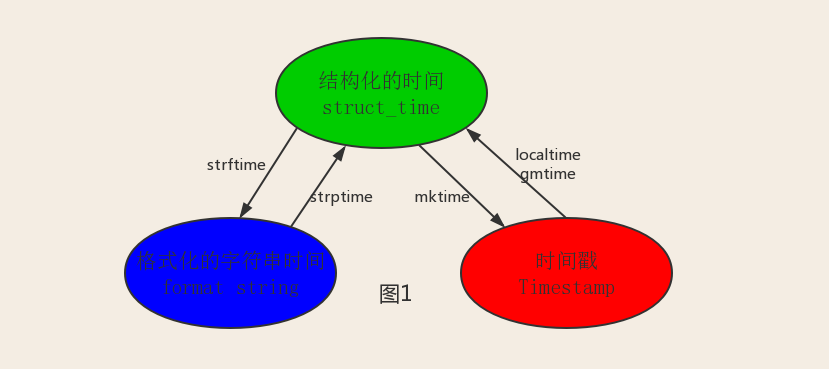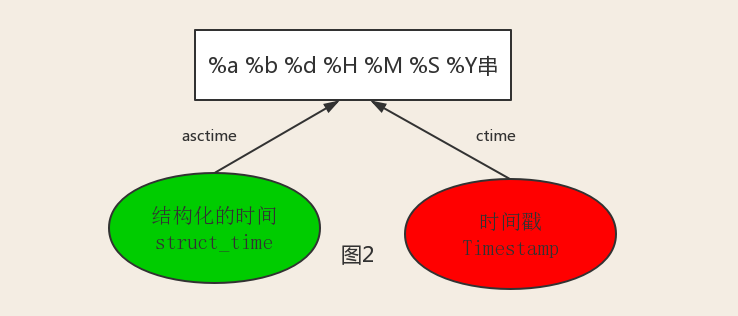day22 常用模块(上)
一、时间模块
1 time模块
获取时间的三种格式:
第一种:time.time()
时间戳(timestamp):从1970年到现在的秒数
#应用场景:计算时间差 可以对时间加减,返回值为浮点型
print(time.time())
>>>1585556158.2177124
第二种:time.strftime()
获取当前具体时间(Format String)
#应用场景:获取当前具体时间,返回值为字符串
print(time.strftime('%Y %m %d %X'))
>>>2020 03 30 16:19:29
具体内置格式化字符串按照需求写
%a Locale’s abbreviated weekday name.
%A Locale’s full weekday name.
%b Locale’s abbreviated month name.
%B Locale’s full month name.
%c Locale’s appropriate date and time representation.
%d Day of the month as a decimal number [01,31].
%H Hour (24-hour clock) as a decimal number [00,23].
%I Hour (12-hour clock) as a decimal number [01,12].
%j Day of the year as a decimal number [001,366].
%m Month as a decimal number [01,12].
%M Minute as a decimal number [00,59].
%p Locale’s equivalent of either AM or PM. (1)
%S Second as a decimal number [00,61]. (2)
%U Week number of the year (Sunday as the first day of the week) as a decimal number [00,53]. All days in a new year preceding the first Sunday are considered to be in week 0. (3)
%w Weekday as a decimal number [0(Sunday),6].
%W Week number of the year (Monday as the first day of the week) as a decimal number [00,53]. All days in a new year preceding the first Monday are considered to be in week 0. (3)
%x Locale’s appropriate date representation.
%X Locale’s appropriate time representation.
%y Year without century as a decimal number [00,99].
%Y Year with century as a decimal number.
%z Time zone offset indicating a positive or negative time difference from UTC/GMT of the form +HHMM or -HHMM, where H represents decimal hour digits and M represents decimal minute digits [-23:59, +23:59].
%Z Time zone name (no characters if no time zone exists).
%% A literal '%' character.
第三种:time.locatime()
struct_time元组共有9个元素共九个元素:(年,月,日,时,分,秒,一年中第几周,一年中第几天,夏令时)
#应用场景:获取具体的单个时间,返回值是一个对象,但是可以看作一个元组对其操作,也可以.元素
res = time.localtime()
print(res)
>>>time.struct_time(tm_year=2020, tm_mon=3, tm_mday=30, tm_hour=16, tm_min=20, tm_sec=38, tm_wday=0, tm_yday=90, tm_isdst=0)
print(res.tm_year)
print(res[0])
>>>2020
>>>2020
重点1
计算机能识别的时间只能是时间戳,而人类能识别的时间是格式化时间,所以有了以下的转化

需求:我们要对‘1999-4-11’时间加1天
#format string--->struct_time--->timestamp
'1999-04-11'
struct_time = time.strptime('1999-04-11','%Y-%m-%d')
print(struct_time)
timestamp = time.mktime(struct_time)+86400
print(timestamp)
new_timestamp = time.localtime(timestamp)
print(new_timestamp)
new_struct_time = time.strftime('%Y-%m-%d-%X',new_timestamp)
print(new_struct_time)
>>>time.struct_time(tm_year=1999, tm_mon=4, tm_mday=11, tm_hour=0, tm_min=0, tm_sec=0, tm_wday=6, tm_yday=101, tm_isdst=-1)
>>>923846400.0
>>>time.struct_time(tm_year=1999, tm_mon=4, tm_mday=12, tm_hour=0, tm_min=0, tm_sec=0, tm_wday=0, tm_yday=102, tm_isdst=0)
>>>1999-04-12-00:00:00

重点2
#--------------------------按图2转换时间
# asctime([t]) : 把一个表示时间的元组或者struct_time表示为这种形式:'Sun Jun 20 23:21:05 1993'。
# 如果没有参数,将会将time.localtime()作为参数传入。
print(time.asctime())
>>>Mon Mar 30 16:49:38 2020
# ctime([secs]) : 把一个时间戳(按秒计算的浮点数)转化为time.asctime()的形式。如果参数未给或者为None的时候,将会默认time.time()为参数。它的作用相当于time.asctime(time.localtime(secs))。
print(time.ctime())
>>>Mon Mar 30 16:52:04 2020
print(time.ctime(time.time()))
>>>Mon Mar 30 16:52:04 2020
2 datetime模块
datetime.datetime.now()
获得当前时间,精确到毫秒
print(datetime.datetime.now())
print(datetime.datetime.now()+datetime.timedelta(days=3))#可以对时间加减
>>>2020-03-30 16:31:23.727911
>>>2020-04-02 16:31:23.728907
print(datetime.datetime.now().replace(minute=3,hour=2)) #可以替换当前时间
二、random模块
import random
print(random.random())#(0,1)----float
>>>#随机取大于0且小于1之间的小数
print(random.randint(1,3)) #[1,3]
>>>#大于等于1且小于等于3之间的整数
print(random.randrange(1,3)) #[1,3) 取头不取尾
>>>#大于等于1且小于3之间的整数
print(random.choice([1,'23',[4,5]])) #在一个列表中随机取元素
>>>#1或者23或者[4,5]
print(random.sample([1,'23',[4,5]],2))
>>>#列表元素任意2个组合
print(random.uniform(1,3))
>>>#大于1小于3的小数,如1.927109612082716
item=[1,3,5,7,9]
random.shuffle(item) #打乱item的顺序,相当于"洗牌"
print(item)
需求:写一个验证码,要求有数字大小写字母
import random
def make_code(size):
str0 = ""
for i in range(size):
str1 = chr(random.randint(65,90))
str2 = chr(random.randint(97,122))
num = str(random.randint(0,9))
str0 += random.choice([str1,str2,num])
return str0
print(make_code(10))
三、os模块
os模块的应用
os.getcwd() 获取当前工作目录,即当前python脚本工作的目录路径
os.chdir("dirname") 改变当前脚本工作目录;相当于shell下cd
os.curdir 返回当前目录: ('.')
os.pardir 获取当前目录的父目录字符串名:('..')
os.makedirs('dirname1/dirname2') 可生成多层递归目录
os.removedirs('dirname1') 若目录为空,则删除,并递归到上一级目录,如若也为空,则删除,依此类推
os.mkdir('dirname') 生成单级目录;相当于shell中mkdir dirname
os.rmdir('dirname') 删除单级空目录,若目录不为空则无法删除,报错;相当于shell中rmdir dirname
os.listdir('dirname') 列出指定目录下的所有文件和子目录,包括隐藏文件,并以列表方式打印
os.remove() 删除一个文件
os.rename("oldname","newname") 重命名文件/目录
os.stat('path/filename') 获取文件/目录信息
os.sep 输出操作系统特定的路径分隔符,win下为"\\",Linux下为"/"
os.linesep 输出当前平台使用的行终止符,win下为"\t\n",Linux下为"\n"
os.pathsep 输出用于分割文件路径的字符串 win下为;,Linux下为:
os.name 输出字符串指示当前使用平台。win->'nt'; Linux->'posix'
os.system("bash command") 运行shell命令,直接显示
os.environ 获取系统环境变量
os.path.abspath(path) 返回path规范化的绝对路径
os.path.split(path) 将path分割成目录和文件名二元组返回
os.path.dirname(path) 返回path的目录。其实就是os.path.split(path)的第一个元素
os.path.basename(path) 返回path最后的文件名。如何path以/或\结尾,那么就会返回空值。即os.path.split(path)的第二个元素
os.path.exists(path) 如果path存在,返回True;如果path不存在,返回False
os.path.isabs(path) 如果path是绝对路径,返回True
os.path.isfile(path) 如果path是一个存在的文件,返回True。否则返回False
os.path.isdir(path) 如果path是一个存在的目录,则返回True。否则返回False
os.path.join(path1[, path2[, ...]]) 将多个路径组合后返回,第一个绝对路径之前的参数将被忽略
os.path.getatime(path) 返回path所指向的文件或者目录的最后存取时间
os.path.getmtime(path) 返回path所指向的文件或者目录的最后修改时间
os.path.getsize(path) 返回path的大小
需要掌握的
import os
#1 os.path.getsize("path") 计算该文件的大小
size=os.path.getsize(r'C:\Users\HZ\PycharmProjects\py学习测试代码\pystudy\text1.py')
print(size)
>>>303
#2 os.path.dirname/basename('path') 获得改文件的父级目录/获得改文件的文件名
print(os.path.dirname(r'/a/b/c/d.txt'))
>>>/a/b/c
print(os.path.basename(r'/a/b/c/d.txt'))
>>>d.txt
#3 如果path是一个存在的文件,返回True。否则返回False
#如果path是一个存在的目录,则返回True。否则返回False
print(os.path.isfile(r'aaa'))
print(os.path.isdir(r'aaa'))
#4 路径处理,返回的是字符串
os.path.dirname(os.path.dirname(os.path.abspath(__file__)))
#获取当前文件的父级的父级路径
四、sys模块
sys模块应用
1 sys.argv 命令行参数List,第一个元素是程序本身路径
2 sys.exit(n) 退出程序,正常退出时exit(0)
3 sys.version 获取Python解释程序的版本信息
4 sys.maxint 最大的Int值
5 sys.path 返回模块的搜索路径,初始化时使用PYTHONPATH环境变量的值
6 sys.platform 返回操作系统平台名称
需要掌握
#我们可以通过设置环境变量的路径来解决跨文件导包的问题
import os,sys
#1 sys.path(本质上是一个列表)
res= os.path.dirname(os.path.dirname(os.path.abspath(__file__)))
sys.path.append(res)
#2 sys.argv(本质上也是个列表)
#这个方法是从文件外部传参的工具
sys.argv[0]=='改文件的路径'
#在终端执行脚本代码 我们在写路径之后可以在写几个值,这些值可以通过sys.argv[]索引的方式找到
补充
#进度条功能
import time
def progress(percent,width=50):
if percent>1:
percent=1
show_str = ('[%%-%ds]'%width)%(int(percent*width)*'#')
print('\r%s %d%%' % (show_str, int(100 * percent)), end='')
data_size = 1024
rev_size = 0
while rev_size<data_size:
time.sleep(0.1)
rev_size+=16
percent = rev_size/data_size
progress(percent)
五、shutil模块
import shutil
shutil.copyfileobj(open('old.xml','r'), open('new.xml', 'w'))
#将文件内容拷贝到另一个文件中
shutil.copyfile('f1.log', 'f2.log') #目标文件无需存在
#拷贝文件
shutil.copymode('f1.log', 'f2.log') #目标文件必须存在
#仅拷贝权限。内容、组、用户均不变
shutil.copystat('f1.log', 'f2.log') #目标文件必须存在
#仅拷贝状态的信息,包括:mode bits, atime, mtime, flags
shutil.copy('f1.log', 'f2.log')
#拷贝文件和权限
shutil.copy2('f1.log', 'f2.log')
#拷贝文件和状态信息

